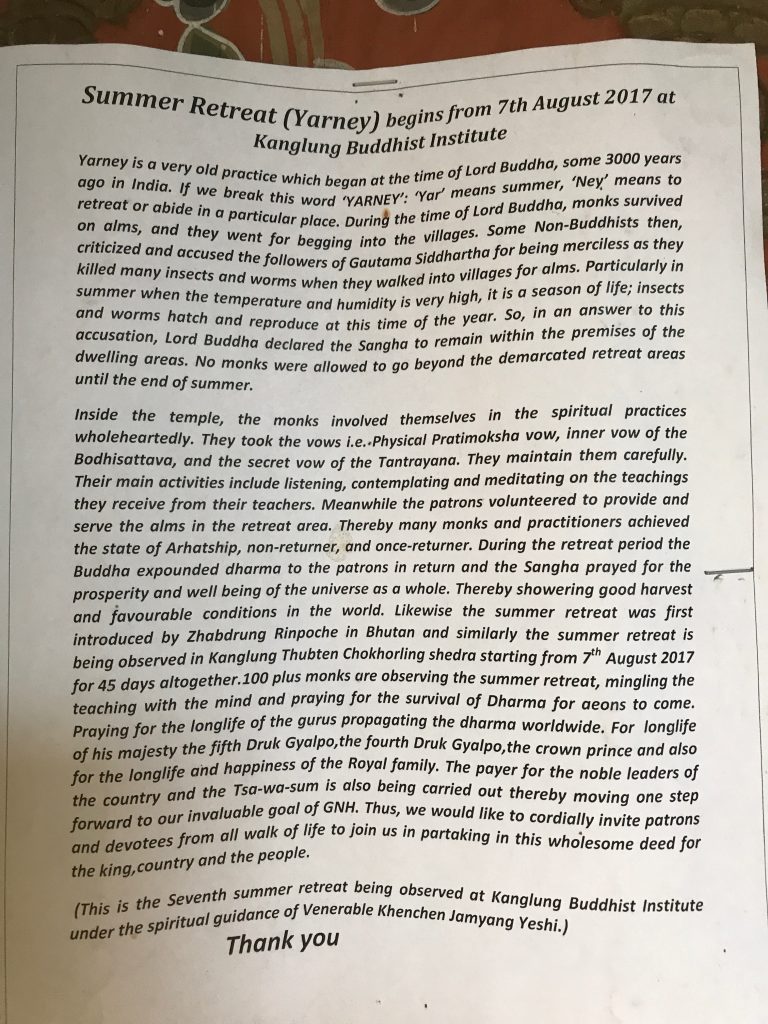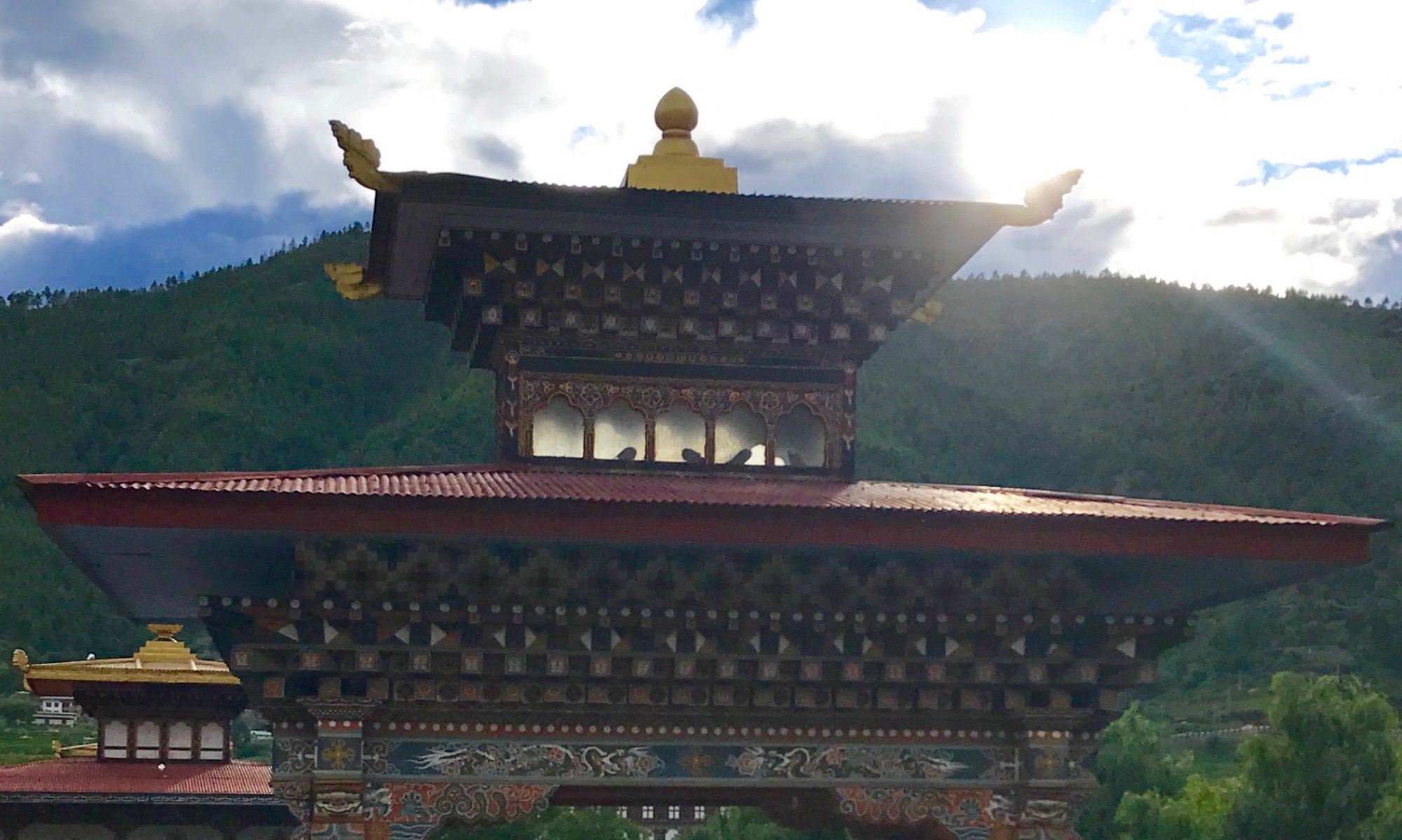I saw Chencho again when I picked Jeremy up at lunchtime. In the end, I didn’t make it down from Yonphula in time to make it to the temple last week, but today, for sure! We arranged to meet at the temple at 4 p.m.
In the end, though, Chencho had a bobble in her schedule: Kinley had to be picked up and she couldn’t make it to the temple in time. So I stood around for a while, awkwardly, at the gate, and then timidly went further. There were some older men and women sitting and walking around the big prayer wheels inside the second gate, close to the temple, so I went there, wondering whether I might find Chencho there. Everyone looked at me with a mix of curiosity and kindness and encouraged me to turn the prayer wheels. So I spent a little time doing that. Then I went out again, and found a younger woman I thought might speak English, and I asked her about this “public program.” She shrugged at me apologetically and motioned inside. Some monks were at the doorway of the temple and they too motioned me in. A young monk greeted me and offered me some holy water. He poured it into my left hand for me to sip (this required some coaching, since I thought my right would be more appropriate). He suggested that I come back at 4:30.
So I walked out of the temple, about ready to give up and go home–at which point, another young monk with better English whisked me off to a room up in the buildings a little further up the hill. This young man was a Sherubtse graduate, and he explained the retreat which had puzzled us. Later, we discovered the printed explanation on the side of the entry:

My new friend (whose name I didn’t catch clearly enough to recall) wanted to give me tea, but I was gracelessly concerned with taking part in “the program.” So he walked me over to the temple. On the way, we met a regional judge (identifiable by his green striped kabney) who was being ushered up for tea. My friend brought me in to the temple and invited me to sit near the statues at the front on the western side of the temple, but the four lines of monks kept glancing over at me, and all the other lay people seemed to be gathered on the eastern side. “Can I go over there?” I asked, and he said, “You want to be there?” in some surprise, but he took me over willingly enough, passing behind the statue of the Buddha and in front of the larger statue of Guru Rinpoche or Padmasambhava. There were Sherubtse students there, sitting on rugs, and they made room for me to join them.
An older woman behind me nudges me and gestures toward the statues. I look at her, trying to figure out what she means, but eventually I give up and face forward again. Another woman nudges me, gestures toward the statues, and holds up her index finger emphatically. I ask the student next to me what it is the women want me to do. “Prostrations,” he replies. I should prostrate three times first toward the monks, then toward the statues. (I try to do full body prostrations as taught by Abbe Blum and witnessed in pilgrims on the road, but I get stuck on the wooden floor with my sweaty hands (and I worry about whether I’m flashing skin between kira and wanju in the process). This is all great comedy for the peanut gallery behind me. Eventually I will learn that the prostrations expected here are tight and tidy, not full body extensions. Also, that the rachu and kabney are very useful in a temple context: one wraps one’s hands in them while doing prostrations.
I arrived just in time for tea, which the students were providing as an offering to the monks; along with the tea came some nibbles (dried pounded corn coated with oil and sugar: very chewy!). “Bhutanese popcorn, ma’am!” Then the students all stood up (“We have to do some work now, madam”) and went up to prostrate to the abbot and receive blessings, after which most of them vanished out of the temple.
A girl in a middle-school uniform arrived and became my mentor. Suddenly everyone was standing up.
“What happens now?” I asked.
“Now we do prostrations, ma’am.”
“How many? Three?”
“Quite a few,” she replied. Then added, with a smile, “Many. So many, ma’am.”
And indeed, it was a workout! Somewhere between twenty and thirty minutes of prostrations: three again to the teachers and then “so many” to the statues. At the end, my new mentor (her name is Sonam Selden, I learned later) asked, “Where are your shoes?” and when I said they were on the other side, she walked me back through the space between the statues, pausing to touch her head against Guru Rinpoche’s shoe. So I did that too. Then we circumambulated the temple three times. Quite the experience all together, but I was glad that I had come alone, to learn the many processes involved in the retreat: I think the others would have been more mortified than I was! But I choose to focus on how kind everyone was in trying to help me find my way.
